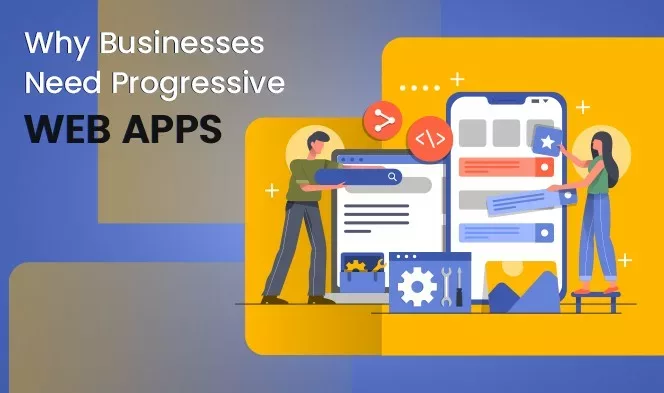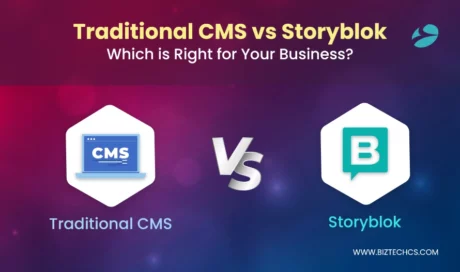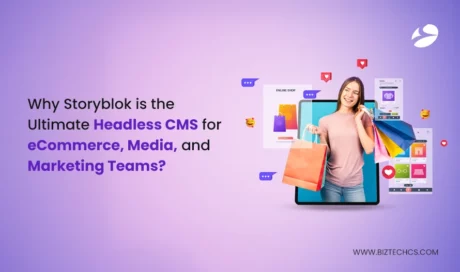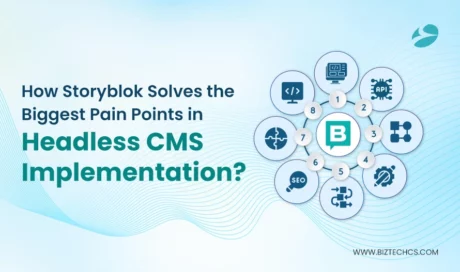Why Businesses Need Progressive Web Apps
17 Aug, 2021
7 min read
17 Aug, 2021
7 min read

The way we engage with applications online is changing rapidly, and along with it, the way applications are developed also changes. From desktops, we have moved to applications, and today it is progressive web applications, i.e., PWAs. They are a new and intuitive way to develop applications that take up less power, storage, and loads faster.
Herein, let’s discuss some of the significant benefits of Progressive Web Apps for web apps development, mobile app development and why businesses need it.
Progressive Web App is a JavaScript technology that allows users to download a website and have faster access to web pages. It combines features of native and mobile applications, which allow users to download the application and use them efficiently. PWAs are lightweight, need less data, and are available offline.
Next up, let’s see the benefits of using progressive web applications:
PWAs do not require different versions for different devices as it is a single progressive application that meets the requirements of all endpoints on which it operates. It reduces the effort that developers provide, and as a result, the cost to develop PWA decreases. It is three to four times fewer than other native mobile applications.
Having user-friendly applications has become a need of the hour to provide a better user experience and rank on various search engines. PWAs provide an advanced user experience by combining the look and feel of mobile applications. Their design and settings are similar to native mobile software, regardless of the tools and frameworks you have developed. This helps you to provide a better user experience, just like native mobile apps. They also provide the same speed, responsiveness, and database access which helps in a better customer experience and achieves customer satisfaction goals. Having good UX helps you to rank on various search engines, App Store, and Play Store.
Users can easily download PWAs, which do not require any installation process. Users can easily download an application from Google Play Store and Microsoft Store, whereas, to access in iOS users can download it directly from the website.
This streamlines the whole process and reduces user abandonment. Once the user downloads it, they can access it via desktop and use it as an application. Some browsers even have a call to action button which prompts users to download these apps when they visit websites.
Google Chrome and Chrome alternatives have been at the forefront of supporting and promoting PWAs, making it easy for users to access web applications seamlessly across different platforms, which can enhance the user experience and increase user engagement.
PWA caches texts, images, and other content efficiently, enabling them to operate like websites and improve the running speed. With quick operation and outstanding performance, it has a positive impact on user experiences and conversion rates. Retailers and content providers can use this type to improve retention and customer loyalty.
PWAs have platform and device freedom; they can satisfy the needs of various consumers and provide a unique user experience on different platforms. One of the latest examples of this is Spotify, users can access desktop apps on Windows and MacOS as it is PWA supported. PWA apps having platform and device freedom helps users to access the app in its full potential by downloading music offline (for premium users), Spotify Connect, starting group listening sessions, sharing music across multiple devices, etc.
PWAs automatically update without notifying users or asking for permission. These apps update themselves whenever users interact with the apps. It eliminates the need to download batch changes and install or reinstall them. They provide a new interface without much human interaction. On the side, some progressive web apps send push notifications to users to inform them about the arrival of new updates. You even have complete control over the information and content that the users have access to; this helps in a better customer experience.
PWAs can work even offline or when the network connection is not stable. Built-in service workers cache important progressive web apps features and information automatically; you don’t need to download it and access it without an internet connection. Based on saving previously accessed information, if they try to open a web page that they have not visited online, an app can show a custom offline page. This will decrease cart abandonment and increase customer retention rates. Hence, PWAs make it easy to access web pages and provide users experience.
Similar to native mobile applications, PWAs have access to device-specific functionality like push notifications. You can perform this in various ways and make the best use of content marketing. Many users allow PWA sites to send notifications which increase opportunities to promote products or services. Users can view these notifications on mobile devices, which results in a high probability of attracting their attention compared to other mediums like email newsletters, blog entries, social media posts, etc. Notifications allow you to send personalized marketing copies, which can help you to convert them into customers. It also helps you have your own brand recognition as it allows a business to draw customers’ attention.
PWAs rely on HTTPs to provide data safety and decrease security risks. It also uses Web Bluetooth technology which includes security capabilities. PWA apps are as secure as applications and help users access them quickly and share their sensitive information without any data theft.
With applications, you need to distribute them in the App, Store, Google Play, and Microsoft Store, but PWAs overcome this limitation. PWAs allow producers to avoid complex reconciliation procedures as they do not need to store on similar services.
Twitter uses PWA for the Twitter Lite platform, which became the default mobile web experience in April 2017. It takes less storage for starting, helps save data usage, and helps them increase the number of tweets, pages per session, and decreased bounce rate.
Uber’s PWA allows you to get the ride without needing to download and install the application. The application is minimal in size, i.e., hardly 50kb, has the core service to function; as a result, it loads faster even when the connection is poor.
If you use Instagram via mobile browser, it is mainly via PWA. The current PWA looks like the traditional app and provides users with extra functionality like uploading pictures as you do in an application.
Forbes moved to Progressive Web Apps, looking at the benefits the platform offers. It focuses on the lightning-quick loading times of PWAs. Previously their mobile website used to take up to 3 to 12 seconds to load, but now with PWA, it loads at 0.8 seconds.
L’Oreal owned Lancôme leverages PWA to provide their users with a better experience. The website loads in 1.7 seconds and matches the brand’s customer experience. It has excellent animations to attract customers and increase their engagement. The sub-navigation menu will help users navigate the website in the right direction; it helps Lancôme to increase their users and turn them into potential customers.
Pinterest’s traditional UI was slow as it is an image-heavy platform that decreased the number of users’ engagement and fewer signups. Soon, they moved to a PWA, which helps them with faster loading and the ability for users to add images to their homepages or download. This helps them with more user engagement on their mobile site.
PWAs are revolutionizing the way users interact with products and services. Using them for your next product has all the significant benefits you cannot even imagine. If you are planning to start with progressive web apps development, you can reach us. We have helped many companies with mobile app development and progressive web application development.
All product and company names are trademarks™, registered® or copyright© trademarks of their respective holders. Use of them does not imply any affiliation with or endorsement by them.

Storyblok
29833
By Devik Gondaliya
02 Apr, 2025

Storyblok
30787
By Devik Gondaliya
01 Apr, 2025

Storyblok
31412
By Devik Gondaliya
27 Mar, 2025